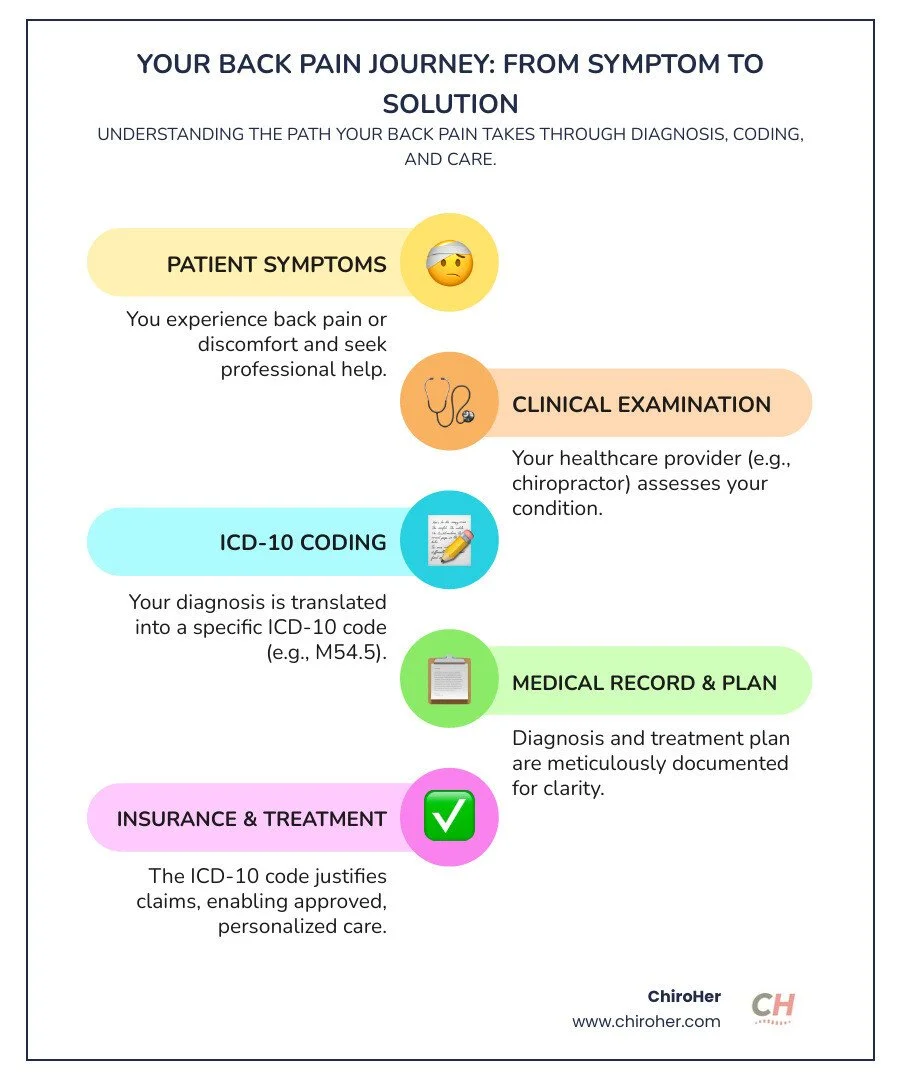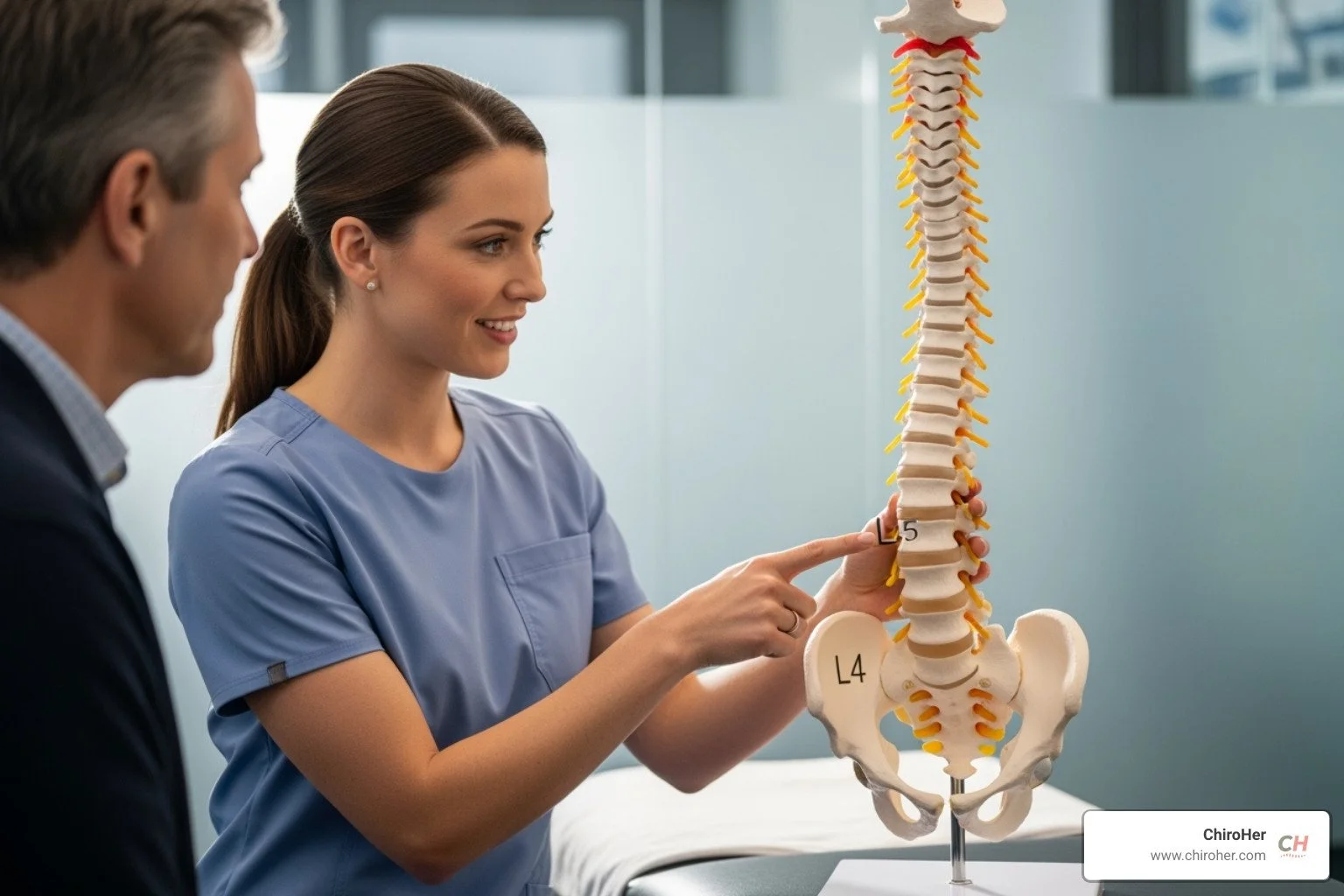Decoding Dorsalgia: Understanding Back Pain ICD-10 Codes
The Language of Back Pain: Why ICD-10 Codes Matter
If you're dealing with back pain, understanding back pain ICD-10 codes can help you communicate more effectively with healthcare providers and insurance companies. These standardized codes translate your symptoms into a universal medical language, ensuring proper diagnosis, treatment, and coverage.
Most Common Back Pain ICD-10 Codes
Code Description Usage M54.9 Dorsalgia, unspecified General back pain without specific location M54.5 Low back pain Pain in the lumbar region M54.50 Low back pain, unspecified Non-specific lower back pain M54.3 Sciatica Pain radiating along the sciatic nerve M54.4 Lumbago with sciatica Combined lower back and leg pain M54.2 Cervicalgia Neck pain
Back pain affects a staggering 619 million people worldwide. If you've ever groaned "oh, my aching back," you're not alone-8 out of 10 people will experience it in their lifetime.
When you visit a provider for back pain, your symptoms are translated into an ICD-10 code. ICD-10 stands for the International Classification of Diseases, 10th Revision, a system from the World Health Organization. These codes are the universal language of healthcare, allowing clear communication between doctors, insurance companies, and researchers.
The medical term for back pain in this system is dorsalgia. These codes do more than label your pain; they help document your diagnosis, justify treatment to insurance, and contribute to public health data.
Hi! I'm Dr. Michelle Andrews, founder of ChiroHer in Oklahoma City. I've spent years helping patients steer their back pain and medical documentation. Understanding back pain ICD-10 codes empowers you to be an active participant in your care and ensures you receive the effective treatment you deserve.
A Comprehensive Guide to Back Pain ICD-10 Codes
When you visit our clinic for back pain, our first step is to understand what's causing your discomfort. We translate this into a specific ICD-10 code. This isn't just paperwork; it's a vital part of your care.
These codes create a clear medical record, ensuring any provider can understand your history. They are also crucial for insurance coverage. When we explain how chiropractic treatment helps in alleviating back pain, the ICD-10 code justifies the medical necessity of our services to your insurer. This lets us focus on your healing, not administrative issues.
Common Codes for General Back Pain (Dorsalgia)
Most back pain codes are in the M54 category, covering dorsalgia (general back pain). The system's precision helps us pinpoint the exact issue.
M54.9 Dorsalgia, unspecified: A starting point for generalized back pain when the specific cause is still being determined.
M54.5 Low back pain: The most common code, as the lumbar region is a frequent source of discomfort. Low back pain often peaks between ages 50-55, with women reporting it more than men. If you need chiropractors for lower back pain in Oklahoma City, we specialize in this area.
M54.50 vs. M54.59: The coding gets more nuanced here. M54.50 is for unspecified low back pain. M54.59 (Other low back pain) is used when we have more details that don't fit other specific categories. You can find more details at resources like 2025 ICD-10-CM Codes M54*: Dorsalgia.
Lumbago: An older term for lower back pain, which points to codes in the M54.5 family.
M54.2 Cervicalgia: This code is for neck pain.
M54.6 Pain in thoracic spine: This covers pain in the middle and upper back.
Differentiating Pain Types: Acute, Chronic, and Beyond
The duration of your pain changes how we code your condition and approach your care.
Acute back pain appears suddenly and lasts for a few days to a few weeks. These cases often use the M54 codes. If an injury caused the pain, we may add an external cause code. Our guide on acute injury definition has more information.
Chronic back pain persists for more than three months and requires a different management strategy. The G89 code category, specifically G89.29 Other chronic pain, is used here. It highlights the persistent nature of the pain. Our article on chronic injuries may be helpful if this sounds familiar.
Understanding the difference between M54, G89, and R52 codes is important.
M54 codes tell us where the pain is (e.g., low back).
G89 codes describe the nature of the pain (e.g., chronic).
R52 (Pain, unspecified) is a general code used when we don't have enough information.
Sometimes we use both M54 and G89 codes together for a complete picture, like M54.5 and G89.29 for chronic low back pain. These distinctions help us design your treatment plan and communicate with your insurer.
Specific Back Pain ICD 10 Codes for Underlying Conditions
Sometimes, back pain is a symptom of an underlying condition. The ICD-10 system has detailed codes for these situations, which helps us provide the right treatment.
Sciatica (M54.3): This is a shooting pain that travels from the lower back down the leg, often caused by a herniated disc or spinal stenosis. Our resource on low back sciatic pain can help you understand it better.
Lumbago with sciatica (M54.4): Used when lower back pain and sciatica occur together. The code can specify the side (M54.41 for right, M54.42 for left).
Herniated discs (M51 category): Occurs when the cushion between vertebrae pushes out and presses on nerves. For example, M51.26 describes a lumbar disc disorder causing nerve pain. Many patients ask, "can chiropractic care help with a herniated disc?" The precise code helps us create a targeted approach.
Spinal stenosis (M48.0): This is a narrowing of the spinal canal that pressures the spinal cord and nerves, causing pain, numbness, or weakness. M48.06 is specific to the lumbar region.
Degenerative Disc Disease (DDD) (M51.3): Describes the natural, age-related wear and tear of spinal discs. M51.36 is for the lumbar region.
Osteoporosis (M80 category): This condition weakens bones, making them prone to fractures. M80.08XA, for example, describes an age-related osteoporosis with a current vertebral fracture.
Sprains and Strains: Injuries have their own codes. S33.5 is for sprains (ligament damage), and S39.012 is for strains (muscle/tendon damage). The codes can be very specific about location and the encounter (e.g., S33.5XXA for an initial encounter for a lumbar sprain).
These specific codes are the foundation for a treatment plan that addresses your exact problem.
The Role of ICD-10 in Diagnosis, Billing, and Treatment
The ICD-10 system is a critical background component of modern healthcare. Here’s how it works:
Universal Classification: Maintained by the World Health Organization, ICD-10 provides a universal language. A code like M54.50 is understood by any provider, anywhere.
Diagnosis Documentation: Codes create a precise record of your condition, helping us track treatment response and making referrals seamless.
Insurance Claims: Accurate codes are vital for insurance claims. They prove medical necessity for services like spinal adjustments or acupuncture, preventing delays or denials.
Treatment Planning: The specific code guides our approach. Care for unspecified low back pain (M54.50) differs from care for a herniated disc with nerve pain (M51.26).
Laterality Codes: ICD-10 can specify the side of the body affected (right, left, or bilateral), allowing for more precise diagnosis and treatment. For example, sciatica can be coded as M54.31 (right side) or M54.32 (left side).
Understanding what a chiropractor does includes appreciating this careful documentation process, which ensures you get the right care covered by insurance.
How Accurate Coding and Chiropractic Care Can Help
At ChiroHer, we handle the complexities of medical codes and insurance so you can focus on healing. Accurately documenting your condition with the correct ICD-10 code is a key part of ensuring you receive the personalized care you deserve.
During your consultation, we perform a thorough examination and translate our findings into precise codes. This detailed approach is part of our commitment to holistic wellness, combining hands-on treatment with meticulous documentation for the best results.
The Benefits of Precise Diagnosis for Your Back Pain
Pinpointing your back pain with a precise ICD-10 code offers several advantages:
Clear Communication: Your diagnosis is understood by any healthcare provider, eliminating confusion.
Smooth Insurance Claims: Accurate codes demonstrate medical necessity to insurers, leading to fewer denials and less financial stress. A code like M54.4 (lumbago with sciatica) is much clearer than a generic "back pain" diagnosis.
Public Health Insights: Your coded diagnosis contributes to data that helps researchers understand back pain on a global scale.
Targeted Treatment: Knowing the exact cause of your pain allows for a customized treatment plan. Natural back pain relief for neck pain (cervicalgia) is different from that for degenerative disc disease.
Patient Empowerment: Understanding your diagnosis (e.g., M54.5 for low back pain) allows you to be an active participant in your care, ask better questions, and make informed decisions.
Improved Outcomes: A precise diagnosis leads to a cohesive care plan, which helps you return to a pain-free life more effectively.
Your Next Steps for Back Pain Relief in Oklahoma City
If back pain is holding you back, we're here to help. At ChiroHer, we offer a comfortable and welcoming environment for treatment. Our boutique clinic provides award-winning, patient-focused care in an upscale setting, with a special focus on women and prenatal clients.
You don't need to worry about ICD-10 codes or insurance-that's our job. We offer personalized, non-invasive options like chiropractic care and acupuncture to address the root cause of your pain and promote long-term spinal health.
We proudly serve Oklahoma City and surrounding areas, including Yukon, Edmond, Nichols Hills, Del City, Mustang, and Moore. Whether you have sciatica, a herniated disc, or another form of dorsalgia, our team can help.
Ready to feel better? Schedule a consultation to discuss your needs and create a custom treatment plan. We'll handle the administrative details so you can focus on healing and getting back to your life.
This guide is for informational purposes and is not a substitute for already established medical advice from your healthcare provider.




